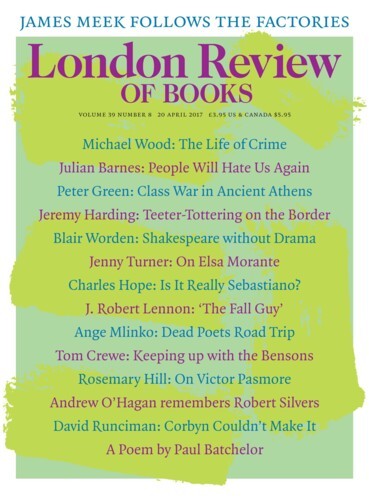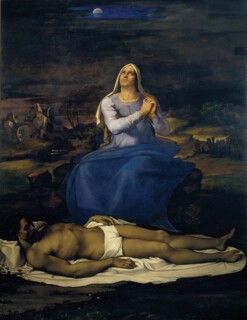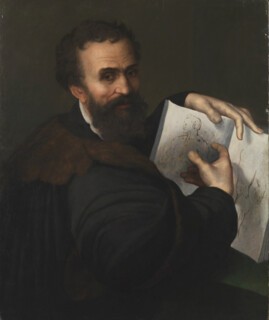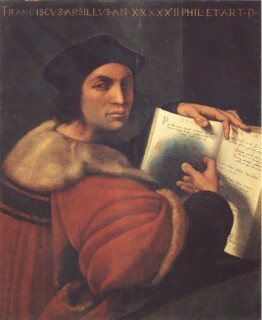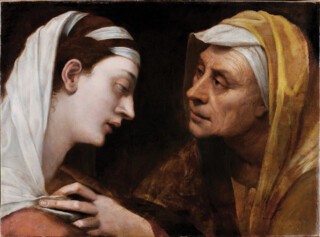The collaboration between Michelangelo and Sebastiano del Piombo, the theme of the beautiful if rather didactic exhibition now at the National Gallery, is one of the strangest episodes in the history of Renaissance art. Sebastiano was born in Venice around 1485, ten years after Michelangelo. Aged about twenty, Sebastiano became attracted by the work of another young local artist, Giorgione. Almost everything associated with Giorgione is now a matter of controversy, but there is general agreement about the identification of most of Sebastiano’s surviving pictures from his time in Venice. These are well represented in the exhibition, and show him as an artist with a distinctive style, although the links with the works of Giorgione and those of his slightly younger contemporary Titian are evident.
In the summer of 1511 Sebastiano moved to Rome at the invitation of a wealthy banker named Agostino Chigi, who wanted him to contribute to the decoration of his new house beside the Tiber, now known as the Villa Farnesina. He could hardly have arrived at a more challenging moment, with Michelangelo in the later stages of painting the ceiling of the Sistine Chapel and Raphael completing the decoration of the Stanza della Segnatura, also in the Vatican. Both these artists had much more experience of fresco painting than Sebastiano, both were vastly more skilled at drawing, and both had developed distinctive figure styles, largely based on surviving fragments of classical sculpture to be seen in Rome, which were to exert an incalculable influence on later European art. Sebastiano’s first works in Rome, a series of mythological frescoes in Chigi’s villa, looked distinctly clumsy by comparison, especially in proximity to Raphael’s celebrated fresco of Galatea.
What happened next is told in the biography of Sebastiano in the first edition of Vasari’s Lives, published in 1550, only three years after his death. Here we learn that Michelangelo was particularly unhappy to discover that many people preferred ‘the grace of Raphael to the profundity of Michelangelo’. He was much impressed by Sebastiano’s ‘colouring’, a term which covered all the effects that could be achieved by the skilful use of paint, in which Venetians had particular expertise, and decided that if he secretly helped Sebastiano with his drawing, he could then praise Sebastiano’s pictures in a seemingly objective way and thus confound his critics. Thanks to Michelangelo’s support and assistance Sebastiano’s reputation was greatly enhanced, but if the fiction that Michelangelo was merely a disinterested admirer of Sebastiano was ever believed, it was soon abandoned. Clients who wanted representations of subjects that would appeal to Michelangelo knew that Sebastiano could provide them and expected that Michelangelo would help him.
The pictures he produced after meeting Michelangelo were very different from those he had painted in Venice. This is true of the subjects, in which themes relating to the passion and death of Christ predominate, and of the colours, which tend to be more muted, narrower in range and darker in tonality than the Venetian paintings. There is an obvious parallel here with the frescoes on the Sistine ceiling before their controversial restoration. Only in Sebastiano’s portraits, a genre in which Michelangelo had no interest, was there a less dramatic change. Unfortunately, because the main theme of the exhibition is the collaboration between the two artists these are not very well represented in London, although there is a wonderful portrait of Pope Clement VII.
The extent of Sebastiano’s dependence on Michelangelo has become increasingly clear with the recognition of how many of his paintings incorporate features developed in Michelangelo’s surviving drawings. This is shown well at the National Gallery, where relevant drawings by both artists are exhibited in the same room as Sebastiano’s paintings. But the surviving evidence about how the two actually collaborated is very incomplete, and it is impossible to say with any degree of certainty what happened in individual cases, although it is known, for example, that Michelangelo provided drawings for the two protagonists in Sebastiano’s large altarpiece of The Raising of Lazarus, which happens to be number 1 in the inventory of the National Gallery’s paintings (it was acquired from the Angerstein Collection, which formed the basis for the new National Gallery’s holdings).
In his drawings Sebastiano never achieved the fluency, expressive power, inventiveness or mastery of anatomy so evident in those by Michelangelo, although he did become increasingly assured. Whether he liked it or not, he remained dependent on Michelangelo for many elements in his compositions, especially for the representation of the male nude. This dependence continued until the early 1530s, when the two fell out, supposedly following a misjudged attempt by Sebastiano to persuade Michelangelo to paint the Last Judgment in the Sistine Chapel in oils rather than fresco. The episode is mentioned in Vasari’s biography of Sebastiano, but, oddly enough, not in that of Michelangelo, and matters may not have turned out quite as Vasari describes. But there does seem to have been an estrangement between the two that lasted almost until Sebastiano’s death; in that period he painted almost nothing.
Vasari explained his lack of activity by the fact that he had been awarded a sinecure by Pope Clement VII, the office of piombatore, responsible for attaching lead seals to papal documents, from which he acquired the name of Sebastiano del Piombo, although this was rarely used in his lifetime. It meant that he didn’t need to work, and could instead devote his time to wine, good food and conversation. His personality seems to have been the reverse of that of the solitary, serious and slightly misanthropic Michelangelo. There is likely to be some truth in Vasari’s explanation, not least because he had first-hand knowledge of the Roman art world and had many acquaintances there who had known Sebastiano well. Of course, without Michelangelo to help him Sebastiano would have found his professional activity much more challenging. But although his encounter with the older artist may have made his career in Rome, it also restricted it, and the longer he stayed there the more difficult it would have been to re-establish himself in Venice. In fact, he only returned once, after the sack of Rome in 1527, and does not seem to have produced anything at all during his visit.
Apart from the familiar Raising of Lazarus, the most impressive painting in the exhibition is the so-called Pietà from Viterbo, one of the first products of Sebastiano’s collaboration with Michelangelo. The wonderful nocturnal landscape, a novelty in Roman paintings, clearly reflects Sebastiano’s Venetian experience, but the dead Christ lying in the foreground and the grieving Madonna seated above him both seem largely inventions of Michelangelo’s. As is often the case with Renaissance paintings, the modern title obscures rather than clarifies the actual subject. An inscription on the original frame indicates that the principal figure is Christ, rather than the Virgin; in this respect it is unlike Michelangelo’s famous sculpture of the Pietà in St Peter’s, a cast of which is displayed opposite the painting in the exhibition, in which the main protagonist is the Virgin. The Viterbo picture is a representation of the body of Christ, the Corpus Domini, a relatively common subject in Italian altarpieces at that period and one to which Sebastiano would return. Michelangelo himself had already depicted it in his early altarpiece now called The Entombment, which belongs to the National Gallery and is also in the exhibition; in both paintings Christ’s wounds are either omitted or are scarcely visible.
Much theological learning is deployed in the catalogue in order to account for the rather masculine features of the Virgin in the Viterbo picture, which are certainly odd, but this kind of explanation is not necessarily relevant. Another painting of a similar subject from St Petersburg, also in the exhibition, shows her in much the same way. Characterisation was never Sebastiano’s strongest suit, and in his depiction of women he usually fell back on a small range of types. In the Viterbo picture he seems to have been defeated by the foreshortening of the head, by the need to show a mature woman and, perhaps, by the limitations of the indications he had received from Michelangelo. But this isn’t the only problematic aspect of the figure. At first sight, the Virgin seems to be praying, but in fact she is wringing her hands in grief. And it isn’t clear why her eyes are turned to the sky, or why she isn’t shown in front of the cross, as she is in a print of this picture from 1566. Although it was widely believed that she grieved over the body after it had been taken down from the cross and before it was placed in the tomb, in Catholic tradition she was not alone. Perhaps Sebastiano simply wanted to emphasise her solitude and isolation, thus arousing feelings of compassion among those who saw the painting, for whom the Virgin would certainly have provoked a much stronger emotional response than the body of Christ.
Apart from a couple of early works from the National Gallery and the Royal Academy Michelangelo is mainly represented in the exhibition by drawings, but there is also a life-size marble figure of the risen Christ. He was commissioned to make this statue in 1514, but the block of marble on which he began working had a flaw where the face would have been, so he abandoned it and started again with another block. The statue on display in London is from the first block. It was completed some time after 1607 and stands in the sacristy of a church in Bassano Romano, north of Rome. Visitors can compare it with a full-size cast of the statue Michelangelo made from the second block, the original being in the Roman church of Santa Maria sopra Minerva. Michelangelo normally worked from the front of a block and probably hadn’t made much progress on the first version before putting it aside. It is therefore virtually certain that none of the actual surface of the statue displayed in the exhibition is by him, and it is an open question how much the pose and proportions of the figure reflect his intentions. On both these issues the author of the relevant catalogue entry is much more optimistic about the extent of Michelangelo’s contribution than I am.
Two other exhibits are even more problematic. In the catalogue a portrait of Michelangelo holding what purports to be an open book of his drawings, said to have been painted around 1520, is described as ‘probably by’ Sebastiano. The attribution has caused some perplexity in the past, but this verdict is too optimistic. The picture isn’t mentioned by Vasari or anyone else, and there is no visual evidence, in the form of prints, of its existence before it was recorded in a French collection in 1960. The pose of Michelangelo is almost identical to that of Sebastiano’s doctor, Francesco Arsilli, in a portrait painted by Sebastiano around 1522, although he was shown on a slightly smaller scale. He holds up a book of the same size, this time filled with Latin poetry, of which he was a noted author. The costume is also very similar, down to the arrangement of the folds; but the colour is different and Michelangelo is shown with a type of collar not worn in Italy until the middle of the 16th century. It is difficult to think of any other instance of a major portraitist repeating himself quite so literally, and seemingly within a period of no more than about three years. The portrait of Arsilli was certainly seen by Michelangelo in Sebastiano’s house, and he would surely not have been happy to discover either that he had been portrayed in just the same way as Arsilli, or that Arsilli had been portrayed in the same way as himself, depending on which came first. Worth mentioning too are the drawings visible on the pages of the book held by Michelangelo. They are taken from a single drawing of a standing nude figure, known in several copies and in an engraving published in 1777. But in the book the head and torso are shown on the left page, and a leg and a hand separately on the right page.
The key to these mysteries is provided by an X-ray fluorescence scan made in about 2014, which reveals beneath the portrait of Michelangelo a well-known composition by the Florentine painter Andrea del Sarto, showing the Virgin and Child with St John the Baptist. The original has been in Rome since about 1790, possibly much earlier, and many copies are recorded. The image beneath the portrait is somewhat smaller than the one in Rome. It is known that in 1517 Sarto painted a picture of an unspecified subject for Sebastiano’s patron Pierfrancesco Borgherini, which for some reason was unsatisfactory. In the catalogue it is suggested that Sebastiano painted Michelangelo’s portrait on top of this very picture, ‘cancelling his Florentine rival’s composition in the process’, not that he had ever met Sarto. The idea that a major artist would treat the work of a prominent contemporary in such a contemptuous and small-minded way seems inconceivable. The circumstances were not like those in which Robert Rauschenberg, in a neo-Dadaist gesture, erased a drawing by Willem de Kooning. And is Borgherini likely to have simply thrown away a painting by Sarto, a leading painter, who was at the time providing pictures for his bedroom in Florence?
Underneath the portrait of Michelangelo there cannot be an original painting by Sarto, but a copy. This would account for the fact that on the back of the panel is a seal allowing its export from the papal state, which must have been applied at some point between 1646 (not 1686 as indicated in the catalogue) and the end of the 17th century. It is easy to see why permission would have been granted to export a copy of this kind, but much less easy to believe that a portrait with the well-known features of Michelangelo could have been exported. In other words, the portrait itself must have been painted after 1646. Everything suggests that it is a modern fake, probably dating from just before its emergence in 1960, and that the forger took the standard precaution of acquiring an old panel on which to paint it. He or she then simply borrowed the composition from a rather obscure portrait by Sebastiano of which photographs had been published, and on the book reproduced a drawing said to be by Michelangelo and available in an engraving.
Equally unconvincing is a small painting in oils on paper that reproduces part of Sebastiano’s Visitation from the Louvre, displayed in the same room, a work that has been in France since soon after its completion and which was very often copied. It is reported in the catalogue, with commendable precision, that the little picture on paper was bought by the current owner at a flea market in Montpellier in December 2008. There are very few known examples of 16th-century Italian artists painting in oils on paper, but no instance has been produced of an artist of that period painting a picture in oils on panel or canvas as well as a full-size version of part of the composition on paper, as is supposedly the case here. It is suggested that the paper version could have served two distinct functions: as a preparatory study for the Visitation and as a record of it. But it is difficult to see how it could have served either purpose, since an important feature of the finished picture, the hand of the Virgin, is missing. This is a detail that a later copyist might well have omitted in the interests of creating a more satisfactory design.
The presence of two works of such dubious status is indicative of the pitfalls involved in exhibiting in a public institution pictures that are or could be on the market, but the practice is now widespread. In other respects the exhibition is a fine achievement. It includes a particularly strong and representative selection of Sebastiano’s religious paintings, and it raises in a very clear way the question of whether these represent his own priorities as an artist, or those of Michelangelo. The display is in rooms on the main floor, rather than in the basement of the Sainsbury Wing, which means that the works are shown to best advantage, though it also means that visitors to the gallery are deprived of parts of the permanent collection they might have expected to see.
Send Letters To:
The Editor
London Review of Books,
28 Little Russell Street
London, WC1A 2HN
letters@lrb.co.uk
Please include name, address, and a telephone number.
